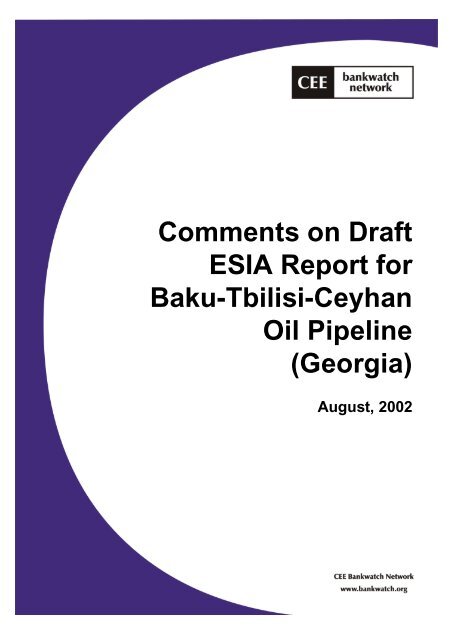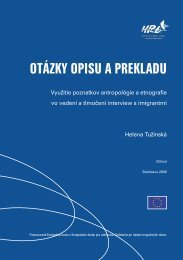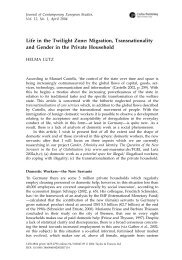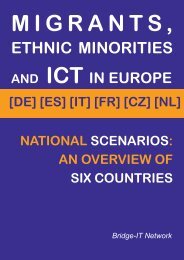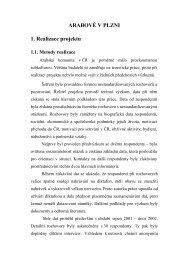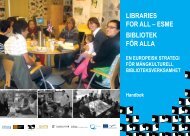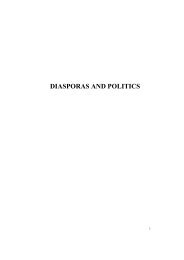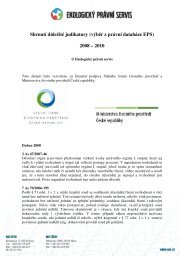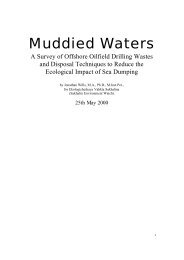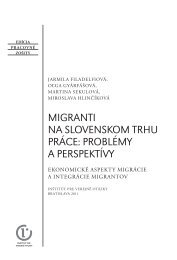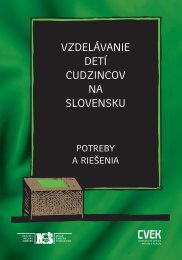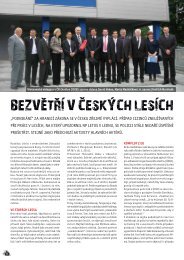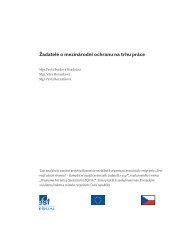Comments on Draft ESIA Report for Baku-Tbilisi-Ceyhan Oil Pipeline
Comments on Draft ESIA Report for Baku-Tbilisi-Ceyhan Oil Pipeline
Comments on Draft ESIA Report for Baku-Tbilisi-Ceyhan Oil Pipeline
Create successful ePaper yourself
Turn your PDF publications into a flip-book with our unique Google optimized e-Paper software.
<str<strong>on</strong>g>Comments</str<strong>on</strong>g> <strong>on</strong> <strong>Draft</strong><br />
<strong>ESIA</strong> <strong>Report</strong> <strong>for</strong><br />
<strong>Baku</strong>-<strong>Tbilisi</strong>-<strong>Ceyhan</strong><br />
<strong>Oil</strong> <strong>Pipeline</strong><br />
(Georgia)<br />
August, 2002
<str<strong>on</strong>g>Comments</str<strong>on</strong>g> <strong>on</strong> <strong>Draft</strong> <strong>ESIA</strong> <strong>Report</strong> <strong>for</strong> BTC pipeline (Georgia)<br />
Introducti<strong>on</strong><br />
The Envir<strong>on</strong>mental and Social Assessment (<strong>ESIA</strong>) <strong>Draft</strong> <strong>Report</strong> <strong>for</strong> the <strong>Baku</strong>-<strong>Tbilisi</strong>-<strong>Ceyhan</strong> (BTC) <strong>Oil</strong><br />
<strong>Pipeline</strong>: Georgian Part (further just <strong>ESIA</strong>) was prepared by ERM, URS and Dzelkva, <strong>for</strong> British<br />
Petroleum Amoco, operator company of BTC Co. These comments address the deficiencies of the<br />
different parts of the <strong>ESIA</strong>, and its compliance with nati<strong>on</strong>al and Internati<strong>on</strong>al legislati<strong>on</strong> and the<br />
requirements of Internati<strong>on</strong>al Financial Instituti<strong>on</strong>s.<br />
In accordance with the Georgian law <strong>on</strong> “Envir<strong>on</strong>mental Permissi<strong>on</strong>s and State Ecological Expertise”,<br />
the Associati<strong>on</strong> “Green Alternative” submitted a Georgian-language versi<strong>on</strong> of this document to the<br />
project sp<strong>on</strong>sor in July 2002.<br />
Main Findings:<br />
Project Alternatives:<br />
The “no project” opti<strong>on</strong> and the opti<strong>on</strong>s <strong>for</strong> routing or different pipeline comp<strong>on</strong>ent design are not very<br />
detailed and do not fully analyse possible implementati<strong>on</strong> of these alternatives.<br />
<strong>Pipeline</strong> route selecti<strong>on</strong><br />
• There is no clear estimate of the risks and socio-ec<strong>on</strong>omic effects of alternative routes in the design<br />
of 10km, 500m or 100m z<strong>on</strong>es.<br />
• While the eastern route has potential advantages <strong>for</strong> pipeline c<strong>on</strong>structi<strong>on</strong>, it has been disregarded due<br />
to security c<strong>on</strong>cerns which are not fully presented nor proven in the <strong>ESIA</strong>. “When combined with the<br />
<strong>for</strong>egoing security c<strong>on</strong>cerns, these issues would have presented significant c<strong>on</strong>straints to any ef<strong>for</strong>ts<br />
by Government and Project pers<strong>on</strong>nel to implement effective risk mitigati<strong>on</strong> and emergency resp<strong>on</strong>se<br />
ef<strong>for</strong>ts. On this basis, and supported by the Government, the administrative boundaries of the district<br />
were c<strong>on</strong>sidered to present unacceptable HSE and other risks <strong>for</strong> the pipeline routing, and the Eastern<br />
Corridor was discounted.” More in-depth investigati<strong>on</strong> of security c<strong>on</strong>cerns and/or a better<br />
presentati<strong>on</strong> of research outcomes is necessary, rather than such general language.<br />
• The pipeline route 500m z<strong>on</strong>e requires revisi<strong>on</strong> and design of the optimal alternative, taking into<br />
account the fact that the present route crosses very sensitive geodynamic areas as well as highly<br />
sensitive areas in the Borjomi and Trialeti Range, where the speed of underground waters is quite<br />
high (6-12m 3 /sec).<br />
The above in<strong>for</strong>mati<strong>on</strong> shows that it is necessary to determine several route alternatives (within<br />
the 10km and 500m z<strong>on</strong>es), with full assessment of all potential risks (geological, hydrogeological,<br />
envir<strong>on</strong>mental) and a least-cost analysis <strong>for</strong> each alternative.<br />
<strong>ESIA</strong> Methodology<br />
The <strong>ESIA</strong>’s methodology lacks clarity, as it does not explain <strong>on</strong> what factors decisi<strong>on</strong>s were made.<br />
The <strong>ESIA</strong> <strong>for</strong> BTC lacks an ec<strong>on</strong>omic evaluati<strong>on</strong> <strong>for</strong> each project comp<strong>on</strong>ent and cost analyses <strong>for</strong><br />
mitigati<strong>on</strong> measures.<br />
While the document often states that particular decisi<strong>on</strong>s were based <strong>on</strong> cost/benefit analyses, it is not<br />
clear what the basis <strong>for</strong> these analyses is. For example, chapter 4 (4.7.8 “Operati<strong>on</strong>al power / fuel<br />
requirements <strong>for</strong> pump drivers”) c<strong>on</strong>cludes that, according to a cost/benefit analysis using BP’s<br />
1
<str<strong>on</strong>g>Comments</str<strong>on</strong>g> <strong>on</strong> <strong>Draft</strong> <strong>ESIA</strong> <strong>Report</strong> <strong>for</strong> BTC pipeline (Georgia)<br />
Envir<strong>on</strong>mental Per<strong>for</strong>mance Guidelines, “direct coupling of the drivers to the pumps was the best<br />
soluti<strong>on</strong>”. BP’s Envir<strong>on</strong>mental Per<strong>for</strong>mance guidelines are not given in the document.<br />
Another example, regarding route selecti<strong>on</strong> methodology:<br />
“Sakire: The route alignment was modified to avoid impacts <strong>on</strong> a summer village used by residents of<br />
Sakire. This village is used during the summer m<strong>on</strong>ths when residents of Sakire take cows and sheep<br />
into the alpine meadows <strong>for</strong> grazing. Owing to the steep valley sides, the optimal route <strong>for</strong> c<strong>on</strong>structi<strong>on</strong><br />
passed through the village and would have required demolishing several of the wooden buildings. Given<br />
the severity of this social impact, an alternative route that passes to the north of the village, requiring<br />
removal of <strong>on</strong>ly a small animal shelter was identified. This alternative route requires felling of additi<strong>on</strong>al<br />
trees as it is in the tree line north of the village, but this was c<strong>on</strong>sidered an acceptable trade-off in order<br />
to avoid the need to relocate structures”. 1 What kind of ec<strong>on</strong>omic, envir<strong>on</strong>mental or social standards<br />
does the <strong>ESIA</strong> use to define the “relocati<strong>on</strong>” of several wooden buildings as “severe” social impact and<br />
route el<strong>on</strong>gati<strong>on</strong> and cutting of additi<strong>on</strong>al trees as an acceptable compromise?<br />
<strong>Pipeline</strong> C<strong>on</strong>structi<strong>on</strong> Methodology<br />
While the project sp<strong>on</strong>sor maintains that the pipeline and all facilities would be c<strong>on</strong>structed according to<br />
internati<strong>on</strong>al standards and regulati<strong>on</strong>s (chapter 5.5.3), the <strong>ESIA</strong>’s project descripti<strong>on</strong> does not clarify the<br />
actual technologies and management standards <strong>for</strong> specific project details, such as the standards used <strong>for</strong><br />
choosing the pipeline well thickness, protecti<strong>on</strong> from corrosi<strong>on</strong>, and so <strong>on</strong>.<br />
It is actually quite important to assess the project’s compliance with IFI requirements. The EBRD, <strong>for</strong><br />
example, requires “best technologies” and “good practice” in project implementati<strong>on</strong>.<br />
It is absolutely unacceptable that several alternative locati<strong>on</strong>s <strong>for</strong> ancillary c<strong>on</strong>structi<strong>on</strong> facilities were not<br />
studied during the <strong>ESIA</strong> preparati<strong>on</strong>s and that the project sp<strong>on</strong>sor admits that “it is not possible to<br />
accurately estimate the degree of disturbance and its significance.” And while the document states that<br />
“the final locati<strong>on</strong> of these sites will require approval by BTC Co such that social and envir<strong>on</strong>mental<br />
factors will be taken into account”, it is in fact up to the Georgian State Agencies, rather than BTC Co, to<br />
issue permits <strong>for</strong> the “final locati<strong>on</strong>” and to guarantee “that social and envir<strong>on</strong>mental factors will be<br />
taken into account”.<br />
Envir<strong>on</strong>mental M<strong>on</strong>itoring methodology<br />
The project’s planned activities (at all implementati<strong>on</strong> stages from preparati<strong>on</strong> to operati<strong>on</strong>) have a large<br />
impact <strong>on</strong> the envir<strong>on</strong>ment, and it is there<strong>for</strong>e necessary to carry out envir<strong>on</strong>mental m<strong>on</strong>itoring<br />
activities. It is vitally important to develop a m<strong>on</strong>itoring program which would became an integral part<br />
of <strong>ESIA</strong> and should include a list of activities necessary <strong>for</strong> m<strong>on</strong>itoring the project’s impacts. The<br />
specifics and intensity (frequency) of m<strong>on</strong>itoring should be determined based <strong>on</strong> each activity’s<br />
durati<strong>on</strong>, potential impact, and the value of the envir<strong>on</strong>mental factor.<br />
Furthermore, the project needs to specify a schedule of deadlines <strong>for</strong> mitigati<strong>on</strong> measures (i.e. dates <strong>for</strong><br />
beginning mitigati<strong>on</strong> activities plus a timeline <strong>for</strong> their durati<strong>on</strong>), taking into the c<strong>on</strong>siderati<strong>on</strong> the<br />
type/specificati<strong>on</strong> of the relevant project activity and envir<strong>on</strong>mental factor. This point is important, as<br />
delayed implementati<strong>on</strong> of mitigati<strong>on</strong> measures could cause irreversible damage to nature (<strong>for</strong> example,<br />
delayed implementati<strong>on</strong> may prove to have little or no mitigating effect).<br />
1 Chapter 4, 4.5.1.6. Stage III, Route Definiti<strong>on</strong> process (100 m)<br />
2
<str<strong>on</strong>g>Comments</str<strong>on</strong>g> <strong>on</strong> <strong>Draft</strong> <strong>ESIA</strong> <strong>Report</strong> <strong>for</strong> BTC pipeline (Georgia)<br />
Compliance with IFC Safeguard Policies<br />
Operati<strong>on</strong>al Policy 4.04<br />
Internati<strong>on</strong>al Financial Corporati<strong>on</strong> Operati<strong>on</strong>al Policy 4.04 clearly states that the “IFC does not support<br />
projects involving the significant c<strong>on</strong>versi<strong>on</strong> of natural habitats unless there are no feasible alternatives<br />
<strong>for</strong> the project and its siting, and comprehensive analysis dem<strong>on</strong>strates that overall benefits from the<br />
project substantially outweigh the envir<strong>on</strong>mental costs”. This overall benefit 2 , according to the IFC,<br />
includes any kind of socio-ec<strong>on</strong>omic and envir<strong>on</strong>mental benefits <strong>for</strong> the regi<strong>on</strong>.<br />
In light of the above, we may note that the document clearly avoids discussing the significance of the<br />
Borjomi regi<strong>on</strong> and, in particular, problems the pipeline may cause to Borjomi Mineral Waters. Neither<br />
the document nor chapter 13 – Cumulative Impact Assessment address this issue properly.<br />
The proposed route crosses surface water catchments of the Borjomi natural springs and boreholes<br />
between KP175.5 and 190. The <strong>ESIA</strong> states that the “potential impacts associated with the co-existence of<br />
the BTC project and the mineral water development taking place at Borjomi have been evaluated in the<br />
c<strong>on</strong>text of an hypothetical oil spill in this regi<strong>on</strong> and how this could affect the surface and groundwater<br />
regime and quality.”<br />
However, the document does not c<strong>on</strong>sider the impact of pipeline c<strong>on</strong>structi<strong>on</strong> in the Borjomi regi<strong>on</strong> <strong>on</strong><br />
potential tourism development and the development of future mineral water producti<strong>on</strong>.<br />
The Borjomi Regi<strong>on</strong> is <strong>on</strong>e of the most well-known tourist destinati<strong>on</strong>s in the <strong>for</strong>mer Soviet Uni<strong>on</strong> and<br />
the most popular resort in Georgia, famous <strong>for</strong> its rich biodiversity and world-famous mineral waters<br />
that are recognised as a strategic resource <strong>for</strong> Georgian ec<strong>on</strong>omy.<br />
The Georgian Glass and Mineral Waters Company (GG&MW) has two plants bottling Borjomi mineral<br />
waters and a glass and plastic bottle factory in nearby Khasuri. About 1200 people are directly employed<br />
in the bottling plants. In 1997, the EBRD and IFC provided USD 20 milli<strong>on</strong> <strong>for</strong> the rehabilitati<strong>on</strong> of the<br />
two mineral water bottling facilities, the glass bottle factory, and a distributi<strong>on</strong> network <strong>for</strong> the mineral<br />
water producer. In 1999-2000, the IFC supported the company's plans to acquire key strategic assets and<br />
strengthen c<strong>on</strong>trol over the brand name Borjomi.<br />
Today’s annual turnover of GG&MW is about USD 60 milli<strong>on</strong> USD, with more than 60% of producti<strong>on</strong><br />
exported to the <strong>for</strong>mer Soviet Uni<strong>on</strong>. According to marketing company “Comc<strong>on</strong>”, Georgian Glass &<br />
Mineral Water occupies 42% of the Russian mineral water market, selling 15 milli<strong>on</strong> bottles in Russia in<br />
2000 al<strong>on</strong>e. Nowadays, GG&MW is expanding at 40% per year.<br />
At the same time, several relatively small factories are also bottling mineral water under the Borjomi<br />
name. The state-owned Big LTD company, <strong>for</strong> example, employs 250 people. About 25% of the<br />
populati<strong>on</strong> is employed in mineral water producti<strong>on</strong>.<br />
The following factors need to be c<strong>on</strong>sidered: 1) total annual income from the pipeline <strong>for</strong> Georgia’s state<br />
budget is USD 64 milli<strong>on</strong> after the pipeline reaches full capacity, 2) c<strong>on</strong>structi<strong>on</strong> would employ <strong>on</strong>ly<br />
2500 people, of whom <strong>on</strong>ly a projected 50-80% would be Georgian, 3) during operati<strong>on</strong>, the pipeline<br />
would employ <strong>on</strong>ly 100-120 people in Georgia.<br />
2 The term "overall benefits" includes all benefits associated with the project, whether they are envir<strong>on</strong>mental, social,<br />
ec<strong>on</strong>omic, or otherwise. Envir<strong>on</strong>mental services such as flood protecti<strong>on</strong>; aquifer protecti<strong>on</strong>, water purificati<strong>on</strong> and<br />
maintenance of biodiversity are all important benefits, which can be attributed to natural ecosystems. The loss of such<br />
benefits, al<strong>on</strong>g with any other envir<strong>on</strong>mental impacts of the development, must be compared to the social, ec<strong>on</strong>omic<br />
and envir<strong>on</strong>mental benefits of any particular development, which is being c<strong>on</strong>sidered. IFC would support the project<br />
<strong>on</strong>ly if the overall benefits substantially outweigh the envir<strong>on</strong>mental costs. (IFC Operati<strong>on</strong>al Policy 4.04. FAQ)<br />
3
<str<strong>on</strong>g>Comments</str<strong>on</strong>g> <strong>on</strong> <strong>Draft</strong> <strong>ESIA</strong> <strong>Report</strong> <strong>for</strong> BTC pipeline (Georgia)<br />
Meanwhile, the project sp<strong>on</strong>sor argues in the <strong>ESIA</strong> that “given the extremely low probability of a spill<br />
occurring in this regi<strong>on</strong>, or elsewhere al<strong>on</strong>g the pipeline, the potential impacts are highly theoretical and<br />
the discussi<strong>on</strong> above needs to be viewed in its appropriate probabilistic c<strong>on</strong>text.” 3<br />
It is necessary <strong>on</strong>ce again to identify the route. In the Borjomi regi<strong>on</strong> we should c<strong>on</strong>sider not <strong>on</strong>ly the<br />
possibility of an oil spill and c<strong>on</strong>taminati<strong>on</strong> of the underlying mineral water aquifer, but also any kind<br />
of possible incident that could result in the loss of mineral water markets outside the country. BP<br />
should take resp<strong>on</strong>sibility <strong>for</strong> such situati<strong>on</strong>s and develop a compensati<strong>on</strong> plan.<br />
Compliance with IFC OP 4.01, 4.04 and IFC Safeguard Guidelines, EBRD<br />
Envir<strong>on</strong>mental Policy<br />
Envir<strong>on</strong>mental acti<strong>on</strong> plans and management plans<br />
Un<strong>for</strong>tunately, the Envir<strong>on</strong>mental Acti<strong>on</strong> Plans are <strong>for</strong> the most part not very detailed and do not comply<br />
with the Internati<strong>on</strong>al Financial Instituti<strong>on</strong>s’ requirements 4 which, according to the project sp<strong>on</strong>sor, <strong>for</strong>m<br />
the foundati<strong>on</strong> <strong>for</strong> preparing the document. 5<br />
While the document argues that the Reinstatement Summary Plan, Landscape Assessment and<br />
Management and Cultural Heritage Management Plan have been fully prepared, no associated costs are<br />
listed, and there are no schedule or descripti<strong>on</strong> of step-by-step required acti<strong>on</strong>s. In those cases where the<br />
step-by-step acti<strong>on</strong>s are prepared, the document states that they are not obligatory and that the c<strong>on</strong>tractor<br />
can alter them. 6<br />
Instead, what exists now is mainly a framework <strong>for</strong> the required plans (Community Safety Management<br />
Plan; Community Liais<strong>on</strong> Management Plan; Worker Camp Management Plan; Infrastructure and<br />
Services Management Plan; Procurement and Supply Management Plan; Employment and Training<br />
Management Plan; Resettlement Acti<strong>on</strong> Plan; Waste Management Plan; Polluti<strong>on</strong> Preventi<strong>on</strong> Management<br />
Plan; Transport Management Plan), and further elaborati<strong>on</strong> in detail would be left up to the c<strong>on</strong>structi<strong>on</strong><br />
c<strong>on</strong>tractor. According to the project sp<strong>on</strong>sor, this set-up complies with IFI rules.<br />
While internati<strong>on</strong>al practice and World Bank OP 4.01 require that Envir<strong>on</strong>mental and Social Plans be<br />
elaborated be<strong>for</strong>e project development and be an essential part of the <strong>ESIA</strong>, these should be discussed<br />
publicly as well.<br />
Any delay in reinstating the pipeline corridor will result in the additi<strong>on</strong>al negative effects menti<strong>on</strong>ed in<br />
Chapter 16, including: negative impact <strong>on</strong> fauna due to l<strong>on</strong>g-term disrupti<strong>on</strong> of habitat, impact <strong>on</strong><br />
species diversity and populati<strong>on</strong>. The risk-factors of the Reinstatement Plan should be studied now, in<br />
order to minimise these factors.<br />
3 Chapter 13. 13.5.4 BTC and the Borjomi Mineral Water development<br />
4 The EAP will document the key issues, the acti<strong>on</strong>s that may be taken to address them adequately, the<br />
implementati<strong>on</strong> schedule and an estimate of the associated costs. (EBRD Envir<strong>on</strong>mental policy &<br />
procedures)<br />
5 IFC Operati<strong>on</strong>al Policy 4.01, article 7: Depending <strong>on</strong> the project, a range of instruments can be used to<br />
satisfy IFC’s EA requirement: envir<strong>on</strong>mental impact assessment (EIA), envir<strong>on</strong>mental audit, hazard or<br />
risk assessment, and envir<strong>on</strong>mental acti<strong>on</strong> plan (EAP). EA applies <strong>on</strong>e or more of these instruments, or<br />
elements of them, as appropriate.” And Annex C of OP 4.01 defines the- c<strong>on</strong>tents and issues that the<br />
EAP should cover.<br />
6 8.4. Procedures <strong>for</strong> Biorestorati<strong>on</strong>, Annex 1, Reinstatement Summary Plan, BTC <strong>ESIA</strong><br />
4
<str<strong>on</strong>g>Comments</str<strong>on</strong>g> <strong>on</strong> <strong>Draft</strong> <strong>ESIA</strong> <strong>Report</strong> <strong>for</strong> BTC pipeline (Georgia)<br />
M<strong>on</strong>itoring and Management<br />
According to the <strong>ESIA</strong> Document, the best tool <strong>for</strong> co-ordinating and m<strong>on</strong>itoring the implementati<strong>on</strong> of<br />
envir<strong>on</strong>mental and social activities is to introduce an Envir<strong>on</strong>mental Management System that includes<br />
social issues. This EMS should be elaborated <strong>on</strong> further – how it will be set up and how it will be<br />
implemented.<br />
The <strong>ESIA</strong> states that such a system should be an important tool <strong>for</strong> setting up all necessary<br />
envir<strong>on</strong>mental and social activities and resp<strong>on</strong>sible organisati<strong>on</strong>s, and <strong>for</strong> directing and m<strong>on</strong>itoring the<br />
implementati<strong>on</strong> of these activities. This means that all envir<strong>on</strong>mental and social issues will be<br />
implemented through the EMS. During operati<strong>on</strong>, the EMS will effectively be based <strong>on</strong> the<br />
envir<strong>on</strong>mental and social plans; we already noted, however, that <strong>for</strong> the most part these plans have not<br />
yet been elaborated. What is more, the EMS itself and its framework have not been fully elaborated and<br />
from the <strong>ESIA</strong>’s general statements about the EMS it is difficult to judge its effectiveness.<br />
Mitigati<strong>on</strong> measures during c<strong>on</strong>structi<strong>on</strong><br />
The Right of Way clearance and preparati<strong>on</strong> of mitigati<strong>on</strong> measures<br />
Mitigati<strong>on</strong> measure 1 – The studies identified by this measure should already be d<strong>on</strong>e and there<br />
c<strong>on</strong>sequently should be an existing package of activities <strong>for</strong> the of maintenance and protecti<strong>on</strong> of rare<br />
and endangered wildlife species and <strong>for</strong> the mitigati<strong>on</strong> of the negative impact of ROW clearance <strong>on</strong> local<br />
flora and fauna. It is quite clear, however, that the impacts <strong>on</strong> wildlife will be quite severe and more<br />
creative approaches <strong>for</strong> their mitigati<strong>on</strong> are needed.<br />
Mitigati<strong>on</strong> measure 2 – First of all, it should be clarified where the revenues from the sale of timber<br />
(from cutting the <strong>for</strong>est) will go. It should be menti<strong>on</strong>ed that <strong>for</strong>est cutting does not <strong>on</strong>ly imply the loss<br />
of “stand-by” trees (timber resource), but also would lead to fragmented destructi<strong>on</strong> of <strong>for</strong>est<br />
ecosystems. This means that the factor of sub-<strong>for</strong>ests should be taken into account. In this situati<strong>on</strong>, the<br />
planting of new trees (even at a 1:1,5 ratio) will not guarantee the restorati<strong>on</strong> of <strong>for</strong>est ecosystems.<br />
To solve this issue, it is necessary to restore the complexity of the destroyed <strong>for</strong>est ecosystem, taking into<br />
account all local plant and animal species. While this is briefly menti<strong>on</strong>ed in Measure 3, the c<strong>on</strong>crete<br />
methodology <strong>for</strong> complex restorati<strong>on</strong> should be elaborated in order to assess its effectiveness. Also, the<br />
functi<strong>on</strong>al value of the proposed cut <strong>for</strong>est should be assessed.<br />
Mitigati<strong>on</strong> measure 5 – The Reinstatement Summary plan <strong>for</strong> temporary roads <strong>on</strong> temporary facilities<br />
should be developed to assess its efficiency.<br />
Mitigati<strong>on</strong> measure 7 – M<strong>on</strong>itoring itself does not represent a mitigati<strong>on</strong> measure, but it is the initial<br />
stage necessary <strong>for</strong> the mitigati<strong>on</strong> measure’s elaborati<strong>on</strong> and implementati<strong>on</strong>. It is <strong>on</strong>ly logical that any<br />
kind of m<strong>on</strong>itoring would have a negative impact in terms of habitat fragmentati<strong>on</strong> and the disturbance<br />
of wildlife sanctuaries. The development of c<strong>on</strong>servati<strong>on</strong> measures <strong>for</strong> particular species and their<br />
immediate/timely implementati<strong>on</strong>, in order to eliminate all negative impacts identified during the<br />
m<strong>on</strong>itoring process, should there<strong>for</strong>e be compulsory.<br />
Mitigati<strong>on</strong> measure 9 – This measure identifies the whole ecosystem as being affected by the Above<br />
Ground Installati<strong>on</strong> c<strong>on</strong>structi<strong>on</strong>, but lists fauna separately and doesn’t include appropriate mitigati<strong>on</strong><br />
measures.<br />
Mitigati<strong>on</strong> measure 19 – The measure identifies local fauna as the project’s noise receptor during<br />
c<strong>on</strong>structi<strong>on</strong>, but does not specify any appropriate mitigati<strong>on</strong> measures.<br />
5
<str<strong>on</strong>g>Comments</str<strong>on</strong>g> <strong>on</strong> <strong>Draft</strong> <strong>ESIA</strong> <strong>Report</strong> <strong>for</strong> BTC pipeline (Georgia)<br />
Issue of pipeline decommissi<strong>on</strong>ing<br />
In order to elaborate the pipeline’s ROW Reinstatement Summary Plan, the issue of decommissi<strong>on</strong>ing<br />
the pipeline after it has finished operati<strong>on</strong> should be discussed further. According to the <strong>ESIA</strong> (chapter<br />
1.4.5.) “it is generally preferable to leave the aband<strong>on</strong>ed line in place as this avoids the envir<strong>on</strong>mental<br />
disturbance associated with removal. The opti<strong>on</strong> of using the pipeline <strong>for</strong> the local/nati<strong>on</strong>al distributi<strong>on</strong><br />
of low-pressure gas, the transportati<strong>on</strong> of water or as a c<strong>on</strong>duit <strong>for</strong> services such as telecommunicati<strong>on</strong>s<br />
cables, could also be c<strong>on</strong>sidered.” This seems to us just a little preposterous.<br />
A decommissi<strong>on</strong>ing plan and financial mechanism <strong>for</strong> its financing should be an integral part of <strong>ESIA</strong>.<br />
Biodiversity protecti<strong>on</strong> strategy<br />
At first glance, a great deal of attenti<strong>on</strong> is devoted to the significance of biodiversity protecti<strong>on</strong>. The<br />
project sp<strong>on</strong>sor is c<strong>on</strong>vinced that document fully complies with Georgian legislati<strong>on</strong> as well as with<br />
internati<strong>on</strong>al c<strong>on</strong>venti<strong>on</strong>s, Internati<strong>on</strong>al Financial Instituti<strong>on</strong> operati<strong>on</strong>al policies and British Petroleum’s<br />
biodiversity strategy.<br />
The operati<strong>on</strong>al policy of Internati<strong>on</strong>al Financial Corporati<strong>on</strong> clearly states, that “IFC does not support<br />
projects involving the significant c<strong>on</strong>versi<strong>on</strong> of natural habitats unless there are no feasible alternatives<br />
<strong>for</strong> the project and its siting, and comprehensive analysis dem<strong>on</strong>strates that overall benefits from the<br />
project substantially outweigh the envir<strong>on</strong>mental costs.”<br />
And British Petroleum’s biodiversity strategy aims to select a “pipeline c<strong>on</strong>structi<strong>on</strong> corridor that avoids<br />
the most sensitive areas, including IUCN Category I to IV sites”. However, passing the route through the<br />
Ktsia-Tabatskuri Managed Reserve fully c<strong>on</strong>tradicts this principle, as this area is protected under IUCN<br />
category IV.<br />
At the same time, IFC Envir<strong>on</strong>mental, Health, Safety Guidelines <strong>for</strong> wild land management 7 require the<br />
implementati<strong>on</strong> of a number of safety measures and plans <strong>for</strong> c<strong>on</strong>serving habitat that exists <strong>on</strong>ly in<br />
project-effected areas. (Black Grouse <strong>on</strong> nearby Tavkvetili Mountain, Orchids <strong>on</strong> Bedeni Plateau)<br />
The c<strong>on</strong>structi<strong>on</strong> phase has a special impact <strong>on</strong> protected sensitive ecosystems and their flora and fauna.<br />
The pipeline ROW will cross sensitive habitats, parts of which are located in the Ktsia-Tabatskuri<br />
Managed Reserve and the support z<strong>on</strong>e of Borjom-Kharagauli Nati<strong>on</strong>al Park.<br />
The pipeline crosses wetlands near Tavkvetili Mountain that represent highly valuable c<strong>on</strong>servati<strong>on</strong><br />
habitat in high mountainous z<strong>on</strong>e due to their rarity and low self-restorati<strong>on</strong> level. This requires<br />
c<strong>on</strong>servati<strong>on</strong> measure implementati<strong>on</strong> during c<strong>on</strong>structi<strong>on</strong> as well as during operati<strong>on</strong> of the pipeline.<br />
The same applies to the Tskhratskaro-Kodiana z<strong>on</strong>e (4.8 km).<br />
The pipeline c<strong>on</strong>structi<strong>on</strong> will have a high residual impact <strong>on</strong> flora due to the clearance al<strong>on</strong>g the ROW<br />
of territories covered by thick primeval <strong>for</strong>ests. This territory includes Tetritskaro and the villages<br />
between Tsikhisjvari and Sakire. As a result of this <strong>for</strong>est clearance, several species of nati<strong>on</strong>al<br />
significance will be affected, including species listed in the Georgian Red Data Book (e.g. high mountain<br />
oak).<br />
7 World Bank wild land, <strong>for</strong>estry sector and biodiversity protecti<strong>on</strong> policies state that the World Bank Group will not<br />
support projects that might result in: disintegrati<strong>on</strong> of a habitat not elsewhere represented in the country and not under<br />
suitable protecti<strong>on</strong>: or the c<strong>on</strong>versi<strong>on</strong> of wild lands of special c<strong>on</strong>cern, including known sites of rare or endangered<br />
species, or important wildlife breeding, feeding and staging areas.<br />
IFC Envir<strong>on</strong>mental, Health, Safety Guidelines <strong>for</strong> wild land management<br />
6
<str<strong>on</strong>g>Comments</str<strong>on</strong>g> <strong>on</strong> <strong>Draft</strong> <strong>ESIA</strong> <strong>Report</strong> <strong>for</strong> BTC pipeline (Georgia)<br />
It is also stated here that, “no significant impacts are expected to occur with regard to <strong>for</strong>estry practice in<br />
Georgia, or to <strong>for</strong>estry management in general, as the <strong>for</strong>ests affected by the proposed pipeline project<br />
are a small fracti<strong>on</strong> of the overall <strong>for</strong>est heritage of the country”. This analysis should follow a different<br />
methodology, as the impact should be assessed not according to the amount of <strong>for</strong>est, but according to<br />
the biodiversity of territories affected by the project, the value of particular species in the ecosystem and<br />
the populati<strong>on</strong> status of individual species.<br />
This chapter also states that the impact of habitat fragmentati<strong>on</strong> <strong>on</strong> mammal migrati<strong>on</strong> in the Tetritskaro<br />
regi<strong>on</strong> has not been assessed. Internati<strong>on</strong>al Financial Instituti<strong>on</strong> regulati<strong>on</strong>s require surveys and<br />
m<strong>on</strong>itoring of migrati<strong>on</strong> to be undertaken now, and not be put off <strong>for</strong> the future, in order to clarify this<br />
issue.<br />
It should be noted that the presented <strong>ESIA</strong> document focuses all its attenti<strong>on</strong> <strong>on</strong> the c<strong>on</strong>servati<strong>on</strong> of<br />
particular species. C<strong>on</strong>cerning their habitat, the <strong>ESIA</strong> states that complex reinstatement would be<br />
undertaken. After an assessment of the impact <strong>on</strong> particular ecosystem comp<strong>on</strong>ents, however, it will<br />
become clear that complex reinstatement will be in all cases almost impossible. Furthermore, the<br />
complex reinstatement plans are not developed at this stage, a step necessary <strong>for</strong> assessing their<br />
implementati<strong>on</strong> and efficiency. It should also be noted that a separate reinstatement plan should be<br />
developed <strong>for</strong> each fragmented habitat. The complex reinstatement plans should be developed<br />
c<strong>on</strong>sidering the degree of impact and the specific habitat’s biodiversity.<br />
Household and Hazardous Waste Management Plan<br />
There is no household and hazardous waste management plan <strong>for</strong> both the c<strong>on</strong>structi<strong>on</strong> period as well as<br />
the operati<strong>on</strong>al period. The project sp<strong>on</strong>sor claims that the c<strong>on</strong>structi<strong>on</strong> c<strong>on</strong>tractor would develop a<br />
c<strong>on</strong>structi<strong>on</strong>-specific waste management plan according to EU directives.<br />
It should be noted that, according to EU Directives 1994/67 and 89/369, British Petroleum agrees to<br />
dispose of part of the household and hazardous wastes in landfills and burn part in municipal<br />
incinerators. We w<strong>on</strong>der which municipal incinerator BP plans to use to burn the waste, taking into<br />
c<strong>on</strong>siderati<strong>on</strong> that there is no incinerator at all in Georgia.<br />
Additi<strong>on</strong>ally, despite the fact that the World Bank and EU allow hazardous waste incinerati<strong>on</strong>, it should<br />
be noted that “successful incinerati<strong>on</strong> requires good design and careful operati<strong>on</strong>. The key operati<strong>on</strong>al<br />
characteristics are temperature, residence time, and turbulence in the combusti<strong>on</strong> chamber, all of which<br />
affect the efficiency of destructi<strong>on</strong>. A poor installati<strong>on</strong> can emit particulates, acidic gases, unburned<br />
wastes, and trace quantities of hazardous organic by-products. Some waste, such as PCBs, require<br />
careful c<strong>on</strong>trol to ensure, <strong>for</strong> example, that minimum temperatures are maintained. Selected wastes can<br />
be incinerated in high-temperature process plants such as cement kilns. However, the waste stream must<br />
be limited to those wastes <strong>for</strong> which full destructi<strong>on</strong> can be ensured and no unacceptable residues are<br />
emitted.” 8<br />
Again, we ask whether BP plans to c<strong>on</strong>struct a new state-of-the-art incinerator; (ignoring <strong>for</strong> a moment<br />
the negative impact which even the best incinerator brings – including heavy metals c<strong>on</strong>taminati<strong>on</strong>, ash<br />
toxicity 9 , gas emissi<strong>on</strong> etc.)<br />
Even stranger is the fact that the <strong>ESIA</strong> does not include any hazardous substances management and<br />
operati<strong>on</strong> plans, as required by the Management of Hazardous Wastes, World Bank Group Polluti<strong>on</strong><br />
Preventi<strong>on</strong> and Abatement Handbook 10 .<br />
8 World Bank Polluti<strong>on</strong> Preventi<strong>on</strong> and Abatement Handbook<br />
9 According to the U.S. EPA, hazardous waste incinerators release ‘thousands’ of PICs (chemicals <strong>for</strong>med during the<br />
incinerati<strong>on</strong> process) in stack gas and deposit them in the residual ashes and liquids of all hazardous waste<br />
incinerators.<br />
7
<str<strong>on</strong>g>Comments</str<strong>on</strong>g> <strong>on</strong> <strong>Draft</strong> <strong>ESIA</strong> <strong>Report</strong> <strong>for</strong> BTC pipeline (Georgia)<br />
We also ask why, taking into c<strong>on</strong>siderati<strong>on</strong> the experience of British Petroleum, the document does not<br />
specify the volume and kind of hazardous substances that will be allowed. Even if we c<strong>on</strong>sider this<br />
strange sentence stating that the c<strong>on</strong>tractor should satisfy the following requirement: “The physical and<br />
chemical properties of the materials should be studied”, just <strong>on</strong>e issue remains to be clarified: Should<br />
this be carried out in Georgia (because it seems that there some new materials) or in the UK using<br />
materials which were already tested during other pipeline c<strong>on</strong>structi<strong>on</strong>s.<br />
Health protecti<strong>on</strong> and security<br />
In order to identify and mitigate any negative envir<strong>on</strong>mental and social impacts during the c<strong>on</strong>structi<strong>on</strong><br />
and operati<strong>on</strong> of the <strong>Baku</strong>-<strong>Tbilisi</strong> <strong>Ceyhan</strong> oil pipeline project, it is necessary to clearly assess all risks<br />
which the project would pose to the health of the populati<strong>on</strong>.<br />
Un<strong>for</strong>tunately, the document does not include any ways <strong>for</strong> identifying of negative impacts of pipeline<br />
c<strong>on</strong>structi<strong>on</strong> and operati<strong>on</strong> <strong>on</strong> the envir<strong>on</strong>ment and public health; or the level of impact risk <strong>on</strong> public<br />
health.<br />
It is vital that the document explain how the sanitary standards requirements of Georgian law will be<br />
satisfied.<br />
For this reas<strong>on</strong>, it is necessary <strong>for</strong> the envir<strong>on</strong>mental and social impact assessment to study the existing<br />
state of public health in order to be able to assess future changes in envir<strong>on</strong>ment and public health<br />
caused by the project. The impacts of pipeline c<strong>on</strong>structi<strong>on</strong> and operati<strong>on</strong> could include more than the<br />
spread of AIDS and infectious diseases, and from our point of view it is necessary to add the risk of<br />
other diseases caused by oil and oil products (as very stable, toxic and carcinogenic substances)<br />
It is doubtful whether the AIDS mitigati<strong>on</strong> measure (training) presented in the document will suffice,<br />
and the statement that “a rise in sexually transmitted diseases is more likely to occur in the large towns<br />
rather than the smaller communities al<strong>on</strong>g the route where prostituti<strong>on</strong> is str<strong>on</strong>gly discouraged because<br />
of more strict social norms” 11 really does not give much relief. Especially interesting is the questi<strong>on</strong> of<br />
what is meant by the “strict c<strong>on</strong>trol” without which “the residual impact of an increase in diseases within<br />
communities could be highly significant in terms of human health”; and what basis exists <strong>for</strong> the “high<br />
expectati<strong>on</strong>” that the impact would be of “medium significance”.<br />
The background in<strong>for</strong>mati<strong>on</strong> presented in secti<strong>on</strong> 7 includes quite scarce in<strong>for</strong>mati<strong>on</strong> – envir<strong>on</strong>mental<br />
baseline in<strong>for</strong>mati<strong>on</strong> – al<strong>on</strong>g with air quality assessment. It is necessary to assess water quality<br />
(including drinking water), soil quality and hygiene baseline.<br />
10<br />
• Define the scope.<br />
• Define the objectives and c<strong>on</strong>straints.<br />
• Formulate the key questi<strong>on</strong>s to be addressed.<br />
• Collect the necessary in<strong>for</strong>mati<strong>on</strong>.<br />
• Prepare a technical assessment of appropriate available technologies.<br />
• Review the existing situati<strong>on</strong> and develop a short list of critical problems and the technical opti<strong>on</strong>s.<br />
• Prepare a number of alternative management plans, based <strong>on</strong> the preferred technical opti<strong>on</strong>s.<br />
• C<strong>on</strong>duct review, discussi<strong>on</strong>, and feedback.<br />
• Make decisi<strong>on</strong>s and carry out implementati<strong>on</strong> and regular m<strong>on</strong>itoring and adjustment.<br />
• Management of Hazardous Wastes, WORLD BANK GROUP Polluti<strong>on</strong> Preventi<strong>on</strong> and Abatement Handbook.<br />
11 Secti<strong>on</strong> 12, residual impact 12-9 pages.<br />
8
<str<strong>on</strong>g>Comments</str<strong>on</strong>g> <strong>on</strong> <strong>Draft</strong> <strong>ESIA</strong> <strong>Report</strong> <strong>for</strong> BTC pipeline (Georgia)<br />
It should be noted that a number of facts described in the baseline in<strong>for</strong>mati<strong>on</strong> do not comply with<br />
reality. For instance, the absence of healthcare facilities in Marneuli, Tetritskaro and Tsalka is not true<br />
and should be clarified 12 .<br />
The document completely ignores the existing water supply situati<strong>on</strong> in communities al<strong>on</strong>g the pipeline<br />
route, specifically which kind of drinking-agricultural water supply systems are used: centralised or<br />
decentralised (water pipe, artesian well, mine well, rivers, water transportati<strong>on</strong>). Furthermore, the water<br />
supply sources are not described (groundwater, open water reservoirs, rivers, reservoirs, lakes and etc.);<br />
neither is the state of the water supply facilities and network or the sanitary safety z<strong>on</strong>es of water supply<br />
sources.<br />
Regarding the quality of water used by the populati<strong>on</strong>: are there any indirect or unintenti<strong>on</strong>al diseases<br />
related to water quality etc; is there any data <strong>on</strong> epidemiological situati<strong>on</strong> and main water polluters<br />
(domestic, industrial or other wastes)?<br />
11.5.1.3. (page 11-45) Water needs <strong>for</strong> c<strong>on</strong>structi<strong>on</strong> and operati<strong>on</strong> – this is defined as the use of surface<br />
and ground waters <strong>for</strong> technical proposes, but the document fails to define used water<br />
purificati<strong>on</strong>/disinfecting measures and discharge locati<strong>on</strong>s, or the installati<strong>on</strong> of water purificati<strong>on</strong><br />
facilities.<br />
11.5.1.6. (page 11-46) Blasting – it should be c<strong>on</strong>sidered that Georgian legislati<strong>on</strong> <strong>for</strong>bids blasting in the<br />
safety z<strong>on</strong>es of resorts and resort areas and in water reservoirs’ sanitary protecti<strong>on</strong> z<strong>on</strong>es.<br />
Table 11-5, (page 11-66), 1.1.6. ROW and open trench – It should be menti<strong>on</strong>ed that the Javakheti<br />
regi<strong>on</strong> c<strong>on</strong>tains epizootic z<strong>on</strong>es and there are places of animal interment; excavati<strong>on</strong> works in this area<br />
should take this epidemiological situati<strong>on</strong> into c<strong>on</strong>siderati<strong>on</strong> and c<strong>on</strong>sult with appropriate field experts<br />
and doctors (epidemiologists).<br />
Public C<strong>on</strong>sultati<strong>on</strong> Process<br />
Availability of in<strong>for</strong>mati<strong>on</strong><br />
The Executive Summaries of BTC and the South Caucasus Gas pipeline distributed by the company<br />
included a questi<strong>on</strong>naire <strong>for</strong> comments. The company welcomed all comments regarding the <strong>ESIA</strong> and<br />
invited people to participate in public hearings, visit www.caspiandevelopmentandexport.com (the<br />
company website) or fill out the questi<strong>on</strong>naire <strong>for</strong>m.<br />
On the web, the draft <strong>ESIA</strong> was available <strong>on</strong>ly in English, although it was promised that other languages<br />
would also be available.<br />
According to BP, the full <strong>ESIA</strong> with Executive Summaries and Community In<strong>for</strong>mati<strong>on</strong> Brochure is<br />
available in local administrati<strong>on</strong> offices. However, because of the badly chosen timing <strong>for</strong> public<br />
disclosure (see below), the true availability of documentati<strong>on</strong> becomes in most cases questi<strong>on</strong>able.<br />
BP also announced that the document would be available at the offices of the Eurasia Foundati<strong>on</strong> and<br />
Horiz<strong>on</strong>ti Foundati<strong>on</strong>. Outside major cities, however, <strong>for</strong> instance at Horiz<strong>on</strong>ti Foundati<strong>on</strong> Akhaltsikhe,<br />
office representatives said that they do not have the documents at the local office.<br />
Only after the local public hearings did BP leave the full set of documents in the local administrati<strong>on</strong><br />
offices. It should be menti<strong>on</strong>ed, however, that those documents were left <strong>on</strong>ly at certain local<br />
12 Table 9.9. (9-32 pages)<br />
9
<str<strong>on</strong>g>Comments</str<strong>on</strong>g> <strong>on</strong> <strong>Draft</strong> <strong>ESIA</strong> <strong>Report</strong> <strong>for</strong> BTC pipeline (Georgia)<br />
administrati<strong>on</strong> offices, <strong>for</strong> instance in Daget-Khachini, while the local hearings were set up <strong>for</strong> a wider<br />
range of settlements including Akhali Samgori, Kumisi and others.<br />
The announcement of public hearings was d<strong>on</strong>e differently in different regi<strong>on</strong>s. While there were public<br />
notices in Tetriskaro, in Akhaltsikhe there were complaints regarding the lack of in<strong>for</strong>mati<strong>on</strong> and there<br />
were no signs in the streets announcing the hearings. The same situati<strong>on</strong> was observed in Daget-<br />
Khachini, where the people in the streets knew nothing about the hearing and we did not even see any<br />
posters in the local administrati<strong>on</strong> building.<br />
In rural areas of Georgia, where there is limited access to newspapers (because of a lack of m<strong>on</strong>ey) and<br />
electr<strong>on</strong>ic <strong>for</strong>ms of in<strong>for</strong>mati<strong>on</strong> (lack of electricity) other <strong>for</strong>ms of advertisement were widely required.<br />
Public Hearings<br />
The company arranged three regi<strong>on</strong>al public hearings (in Rustavi, <strong>Tbilisi</strong> and Borjomi), plus ten local<br />
public hearings. All public hearings started at 11 a.m. or 2 p.m. <strong>on</strong> working days. This fact was <strong>on</strong>e of<br />
the main obstacles keeping people from attending the meeting – in more urban areas (such as<br />
Akhalstsike, where many interested people such as university teachers were unable to participate because<br />
of work) as well as in rural areas (where many people at this time in June are still per<strong>for</strong>ming<br />
agricultural activities).<br />
Practice shows that important places such as <strong>Baku</strong>riani, Tsalka, and other key places were missed. The<br />
frequency of the public meetings was not satisfactory. While the company can argue that the public<br />
hearings in Tsikisjvari and Borjomi 13 met the needs of <strong>Baku</strong>riani district, we should underline that due to<br />
poor roads and poor timing, part of populati<strong>on</strong> was not able to participate in hearings.<br />
Timing <strong>for</strong> Public Disclosure<br />
Timing <strong>for</strong> public disclosure was chosen very badly. The local electi<strong>on</strong>s <strong>on</strong> June 2nd reduced local<br />
administrati<strong>on</strong>s’ ability to play an active and effective role. They could not adequately distribute project<br />
documentati<strong>on</strong> to local communities prior to the c<strong>on</strong>sultati<strong>on</strong> process, nor could they adequately explain<br />
the importance of the documents, the required procedures and public input. Communities often<br />
complained that they could not get answers from local governments regarding the documents. There are<br />
two reas<strong>on</strong>s <strong>for</strong> this: 1) Electi<strong>on</strong> results were officially announced <strong>on</strong>ly <strong>on</strong> June 13th and most local<br />
governmental representatives avoided making any kind of statements; 2) local administrati<strong>on</strong>s have<br />
limited capacity and knowledge <strong>for</strong> helping people adequately prepare <strong>for</strong> local hearings.<br />
Comment period<br />
While the official public disclosure period lasted until July 31st (according to Georgian law), the<br />
questi<strong>on</strong>naire asked people to submit comments until the middle of July.<br />
Minutes from the Meetings<br />
Best Practices of Public Participati<strong>on</strong> requires the preparati<strong>on</strong> of minutes of the public hearing and <strong>for</strong><br />
the minutes to be distributed am<strong>on</strong>g local authorities and interested parties. In fact, no minutes were ever<br />
sent to local administrati<strong>on</strong> offices although they repeatedly requested this to be d<strong>on</strong>e.<br />
13 or in a case of Tsalka in Beshtasheni and Kizil-Kilisa<br />
10
<str<strong>on</strong>g>Comments</str<strong>on</strong>g> <strong>on</strong> <strong>Draft</strong> <strong>ESIA</strong> <strong>Report</strong> <strong>for</strong> BTC pipeline (Georgia)<br />
Public Disclosure ph<strong>on</strong>e<br />
The public disclosure ph<strong>on</strong>e line (8 99 96 34 17) was not a toll-free number. The public there<strong>for</strong>e had<br />
limited possibilities <strong>for</strong> calling and discussing issues over the ph<strong>on</strong>e.<br />
C<strong>on</strong>tent of Public Hearings<br />
While BP attempted to follow the IFC’s Best Practices Manual <strong>for</strong> managing public c<strong>on</strong>sultati<strong>on</strong>s, and<br />
tried to build dialogue and trust am<strong>on</strong>g the people to manage expectati<strong>on</strong>s in order to “avoid unrealistic<br />
demands and expectati<strong>on</strong>s”, “be clear and firm”, “try not to overstate the benefits” or not to raise<br />
expectati<strong>on</strong>s, it seems that all of these measures were not adequate.<br />
It should be noted that, in the beginning, the BTC pipeline in Georgia raised very high expectati<strong>on</strong>s<br />
am<strong>on</strong>g the public and BP’s ef<strong>for</strong>ts to counter these high expectati<strong>on</strong>s through <strong>on</strong>ly the c<strong>on</strong>sultati<strong>on</strong><br />
process did not succeed. Although BP tried to clearly and firmly address the issue of expectati<strong>on</strong>s during<br />
the hearings, the company <strong>on</strong>ly provided in<strong>for</strong>mati<strong>on</strong> <strong>on</strong> what communities should not expect from BP,<br />
while leaving open the questi<strong>on</strong> of what they could expect from the company.<br />
According to the IFC Best Practices Manual, Guidance Note 6: “To be most effective public meetings<br />
should be employed to gain local acceptance <strong>for</strong> mitigati<strong>on</strong>, compensati<strong>on</strong>, and project benefits opti<strong>on</strong>s<br />
that have already been agreed in principle through earlier c<strong>on</strong>sultati<strong>on</strong>. Meetings are likely to be less<br />
effective when used as the sole means of in<strong>for</strong>mati<strong>on</strong> disclosure and public c<strong>on</strong>sultati<strong>on</strong>.” Un<strong>for</strong>tunately,<br />
the public hearings in Georgia ignored this advice.<br />
Problems such as land compensati<strong>on</strong>, energy supply, infrastructure development and<br />
employment, which represent the local populati<strong>on</strong>’s highest c<strong>on</strong>cerns, were not adequately<br />
addressed. At practically every meeting, the people expressed their dissatisfacti<strong>on</strong> regarding the<br />
lack of in<strong>for</strong>mati<strong>on</strong> <strong>on</strong> the above menti<strong>on</strong>ed issues.<br />
Land acquisiti<strong>on</strong> and compensati<strong>on</strong> issue<br />
During the public hearings the questi<strong>on</strong> of land acquisiti<strong>on</strong> and compensati<strong>on</strong> was <strong>on</strong>e of the most<br />
burning issues. However, the company could not answer any specific questi<strong>on</strong> as the resettlement acti<strong>on</strong><br />
plan had not yet been prepared and there was also no in<strong>for</strong>mati<strong>on</strong> <strong>on</strong> how different types of land would<br />
be compensated (the c<strong>on</strong>cern is not <strong>on</strong>ly about numbers <strong>for</strong> different-quality lands, but also c<strong>on</strong>cern <strong>on</strong><br />
different types of land such as agricultural, pasture, n<strong>on</strong>-urban and household).<br />
The explanati<strong>on</strong> that all negotiati<strong>on</strong>s with landowners would be carried out <strong>on</strong> an individual basis did<br />
not solve the situati<strong>on</strong>.<br />
Employment Opportunities<br />
During the public hearings, BP clearly stated that <strong>on</strong>ly 2500 people would be employed during<br />
c<strong>on</strong>structi<strong>on</strong>, of whom <strong>on</strong>ly 50-80% would be Georgian. It was also underlined, however, that the<br />
c<strong>on</strong>tractor would define the final number of Georgian employees.<br />
At the same time, the company failed to make any clear statement denying promises to deliver 70 000<br />
jobs 14 . In fact, many recruitment offices (governmental and n<strong>on</strong>-governmental) have already started the<br />
14 This type of promise is widely circled in Georgian society, and even was expressed by various parties during the<br />
public hearings. Similar claims could be seen in various newspapers e.g. newspaper, 24 saati, 15 July, 2002;<br />
11
<str<strong>on</strong>g>Comments</str<strong>on</strong>g> <strong>on</strong> <strong>Draft</strong> <strong>ESIA</strong> <strong>Report</strong> <strong>for</strong> BTC pipeline (Georgia)<br />
registrati<strong>on</strong> process in the main towns. There was little warning that people should register <strong>on</strong>ly in<br />
offices established by the BP c<strong>on</strong>tractor. In Borjomi regi<strong>on</strong> al<strong>on</strong>e, already 5000 people have registered<br />
with a job recruitment office, while in Akhaltsikhe and Tetriskaro there are about 2000 each. All of these<br />
people believe that they have been already registered <strong>for</strong> work 15 .<br />
Social Investment Programme<br />
While BP recognises corporate resp<strong>on</strong>sibility and talks about Social Investment Programs, local people<br />
have not received any in<strong>for</strong>mati<strong>on</strong> regarding the proposed amount of investment package.<br />
At the same time, people clearly require the energy supply (electricity and gas), all the public hearings. In<br />
the <strong>ESIA</strong>, the project sp<strong>on</strong>sor recognises these expectati<strong>on</strong>s.<br />
During the public hearings, however, the project sp<strong>on</strong>sor avoided discussing the above menti<strong>on</strong>ed<br />
issues, something which <strong>on</strong>ly irritated the public. The discussi<strong>on</strong> was often directed towards<br />
rehabilitati<strong>on</strong> of schools and kindergarten.<br />
C<strong>on</strong>clusi<strong>on</strong>s:<br />
• The <strong>ESIA</strong> lacks baseline in<strong>for</strong>mati<strong>on</strong> in several areas (biodiversity, hygiene, health, socio-ec<strong>on</strong>omic<br />
c<strong>on</strong>diti<strong>on</strong>s), that require additi<strong>on</strong>al study;<br />
• There is a lack of c<strong>on</strong>siderati<strong>on</strong> of alternative pipeline routing that might be preferable from an<br />
envir<strong>on</strong>mental point of view;<br />
• The <strong>ESIA</strong> lacks various Acti<strong>on</strong> Plans (including the Envir<strong>on</strong>mental M<strong>on</strong>itoring Plan, Resettlement<br />
Acti<strong>on</strong> Plan and Hazardous Risk Management) with clearly stated goals, implementati<strong>on</strong> schedule and<br />
associated cost, as is required by the Netherlands legislati<strong>on</strong> and IFC and EBRD policies.<br />
• The methodology of the <strong>ESIA</strong> and cost/benefit analyses (including the analyses of route selecti<strong>on</strong>,<br />
socio-ec<strong>on</strong>omic parameters <strong>for</strong> choosing different project comp<strong>on</strong>ents and specific standards <strong>for</strong><br />
each project comp<strong>on</strong>ent) is unclear.<br />
• Public participati<strong>on</strong> was of little value to affected communities in terms of providing exact<br />
in<strong>for</strong>mati<strong>on</strong> <strong>on</strong> the project, land compensati<strong>on</strong> and employment<br />
15 In some cases they have paid m<strong>on</strong>ey <strong>for</strong> registrati<strong>on</strong><br />
12


